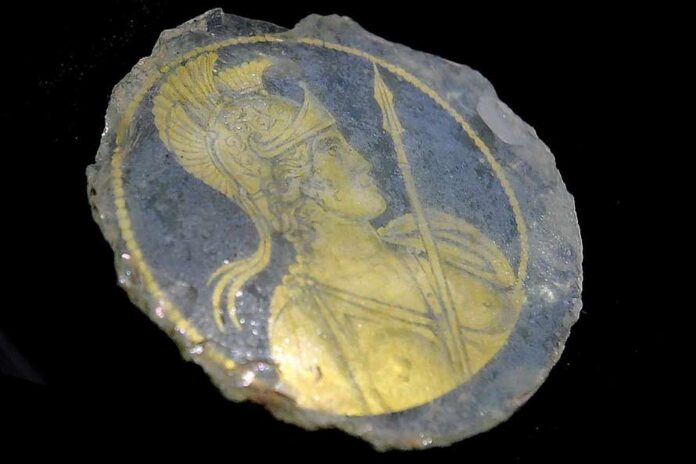Samples with Greco-Roman, Christian and Jewish iconography have been found. The first and only known personification of Rome in ancient gold glass was discovered during the construction of Metro Line C in Rome. It was found at the Porta Metronia station, where a military barracks was excavated in 2016.
The figure shown on the glass is depicted in profile, wearing a helmet and military gear and holding a spear—a well-known form of representation among ancient Romans.
The glass would have originally been placed at the bottom of a cup so that the person using it could look at it while drinking. It likely would have been a gift.
According to Rome News, the golden glass artifact will be on display at the new metro station museum. “Golden glass is already a very rare find, but according to preliminary data, it has no comparison,” Simone Morretta, archaeologist of the Rome Special Administration, told ANSA. “Golden glass with the personification of the city of Rome has not been found before.”
Golden glass was a glassmaking technique in which a thin layer of decorated gold leaf, often a portrait, was placed between two layers of clear glass. The sheet was first glued to one of the glass discs, and then the design was created by scratching tiny sections of the gold, like an engraving. A second glass disc was then placed over the etched gold surface and fused to create the vessel or medallion.
The process of pouring a thin film of gold into glass originated in Hellenistic Greece (4th-3rd century BC), but glassblowers of the late Roman Empire (3rd-4th century AD) perfected it to create true portrait miniatures in medallions. The portraits can be strikingly realistic, and the portraits made in Alexandria are sometimes very close in style to those of the Fayuum mummies.
Examples with Greco-Roman, Christian, and Jewish iconography have been found, many of them deliberately broken, with a decorated base affixed to a wall next to burial niches in the catacombs of Rome. About 500 pieces of Roman gold glass, almost Christian, were found in the catacombs. Pagan, Christian, and Jewish gold glass vessels contain traditional phrases such as “vivas” (“you live”), which were common Roman expressions for good luck and libation.
This suggests that they were made in shared workshops and the images were altered to appeal to people of different faiths. The newly discovered personification of the Eternal City has no inscription. She wears an Amazonian-style dress, a plumed crested helmet, and a tiara on her forehead. She wears a spear on her chest. The details are very fine, from the curls of her hair to the curls on her helmet.
Like the medallions found in the catacombs, the golden rum was carved from a vessel, probably when it was damaged, and kept as a precious display item. However, it was not installed on the wall of the barracks. The military left this place in the middle of the 3rd century, and the remaining structure was cut down and buried.
The tops of the walls were demolished and the site was littered with debris. In this bulk layer, golden glass was found, which dates back to the beginning of the 4th century.
Porta Metronia station is scheduled to open at the end of 2024. This is a great location for a museum, a short pleasant walk from the Via Appia along a grassy park along a well-preserved section of the Aurelian Wall.

























